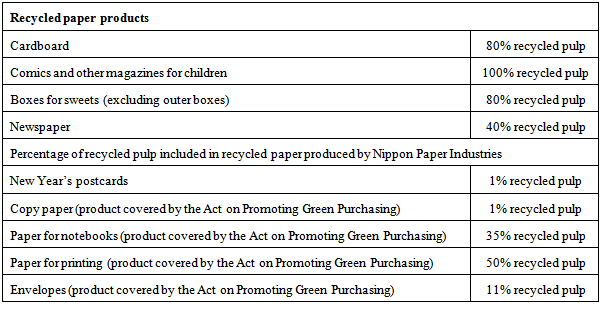-
Paper Information
- Previous Paper
- Paper Submission
-
Journal Information
- About This Journal
- Editorial Board
- Current Issue
- Archive
- Author Guidelines
- Contact Us
World Environment
p-ISSN: 2163-1573 e-ISSN: 2163-1581
2014; 4(2): 67-74
doi:10.5923/j.env.20140402.03
Human Society Viewed from the Perspective of 3R-Eco Activities and Environmental Measures: Part II - Relationships between the Use of Waste Paper, Recycling of Used Paper, and Environmental Burden -
Masakazu Yamashita, Kazuto Suzuki
Department of Environmental Systems Science, Doshisha University, 1-3 Miyakodani, Tatara, Kyo-tanabe, Kyoto, 610-0394, Japan
Correspondence to: Masakazu Yamashita, Department of Environmental Systems Science, Doshisha University, 1-3 Miyakodani, Tatara, Kyo-tanabe, Kyoto, 610-0394, Japan.
| Email: |  |
Copyright © 2014 Scientific & Academic Publishing. All Rights Reserved.
Recycling is one of the eco-activities that have been aggressively promoted in recent years. Recycling of plastic bottles, cans, and paper is particularly common in Japan. However, there have been changes in the use of waste paper and recycling of used paper over the past few years as society and the paper industry change. The present study discussed recycling of paper in Japan, focusing on effective paper recycling activities and their methods. The results suggest that the efficacy of paper recycling is high when products using low-quality recycled paper are required. Waste sheets and other paper that could be easily recycled were useful resources. Although high-quality paper products require virgin pulp, waste paper serves as a valuable resource when it is used for low-quality paper products, such as cardboard and magazines. However, the recycling of paper does not directly reduce the environmental burden. The study results also suggest that the environmental burden is not reduced as expected because of significant differences in the processes of producing paper using recycled and virgin pulp. The present study discussed the “effective and efficient use of waste paper” and “relationship between paper recycling and the environmental burden” based on the results of a market price survey involving recycled paper products and recent trends in the paper industry. The results suggest that the recycling of paper is effective if waste paper is used appropriately.
Keywords: Recycling, Used paper, Waste paper, Eco-activity, Pulp
Cite this paper: Masakazu Yamashita, Kazuto Suzuki, Human Society Viewed from the Perspective of 3R-Eco Activities and Environmental Measures: Part II - Relationships between the Use of Waste Paper, Recycling of Used Paper, and Environmental Burden -, World Environment, Vol. 4 No. 2, 2014, pp. 67-74. doi: 10.5923/j.env.20140402.03.
Article Outline
1. Introduction
- The 3R eco-activities refer to Reduce, Reuse, and Recycle. Most of the eco-activities implemented in Japan and other countries are based on the concept of one of the three activities. In Japan, recycling usually refers to the “reuse of resources”. The concept is to “reuse waste and used products repeatedly”. Of the 3R eco-activities, recycling is the most common one in Japan, and attention is particularly focused on the recycling of paper, plastic bottles, and cans [1-3].Recycling of waste is very attractive. However, recycling has serious problems, as many experts have pointed out in recent years [4]. Some researchers suggest that recycling, in which various technologies are used, eventually increases the environmental burden. Others point out that most countries have difficulty retrieving recyclable waste, even if effective methods and technologies are available.The present study discussed paper recycling, among others, which is the oldest and most common recycling activity in Japan.Recycling of plastic bottles and cans is also widely known, and paper recycling is one of the eco-activities that have been promoted in recent years. However, recycling activities are significantly influenced by the users of recycled products and trends in society. The study was conducted to examine the requirements for conducting effective recycling activities in human society as well as their effects on reducing the environmental burden.Our research was based on the assumption that, in order to establish “an ideal relationship between society and environmental measures”, it is necessary to implement effective environmental measures while taking into account the fact that humans live in society. The present paper presents findings on paper recycling, as a conclusion. However, recycling still has a variety of problems to be addressed, including erroneous information on the ratio between recycled and virgin pulp, exemplified by an incident publicized by the media during the research period [5].
2. Status of Paper Recycling
- Among various recycling activities, paper recycling, including copy paper, postcards, and envelopes made of recycled pulp, is very popular. Some people were involved in paper recycling activities even before they started to attract attention.
2.1. Current Status of Recycled Paper
- Waste paper is recycled into reusable paper products. The question: “What is recycled paper?”, cannot be answered because “it has not been clearly defined” [6]. Although most people associate recycled paper with reusable paper made of recycled pulp, the definition is vague. According to this definition, all paper products can be referred to as recycled paper even if they only include a very small amount (e.g., 0.1%) of recycled pulp. Although an indication of the percentage of recycled pulp is printed on some recycled paper products in Japan, this is not mandatory. Therefore, there is no way of determining the environmental effects of such products if there is no indication of the ratio between recycled and virgin pulp. In fact, news on the false indications of the ratio made by “five major paper manufacturing companies” made the headlines in January 2008 [5]. In these cases, the ratio between recycled and virgin pulp was fabricated. This also means that only printing an indication of “recycled paper”, instead of the ratio, would circumvent such an incident. Failure to indicate the ratio constitutes a violation of the Act on Promoting Green Purchasing promoted by the government. However, no penalty is imposed for a violation of the law, as described later.
2.2. Awareness of Recycling among Consumers
- Awareness of paper recycling among consumers is also high. Since large amounts of paper are used in daily life and it is very familiar, most Japanese people can accept the concept of paper recycling and purchase recycled paper products. Japan is a top-ranked user of recycled paper in the world, as shown in Figure 1 [7]. Furthermore, Japanese imports of recycled paper have been very small in recent years, as shown in Figure 2 [8]. As a large volume of waste paper is collected domestically, Japan is principally an exporter, not an importer.Paper recycling activities are popular in Japan, and the collection and reuse of waste paper are very effective when exports of recycled paper are taken into account.
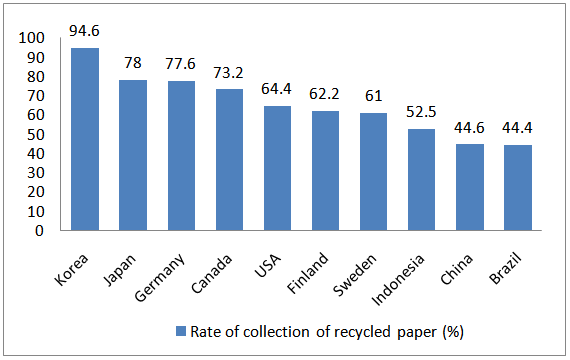 | Figure 1. Rates of the use of recycled paper in Japan and other countries [7] |
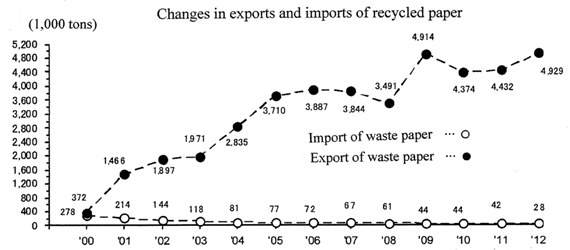 | Figure 2. Changes in exports and imports of recycled paper [8] |
2.3. Responses by the Government
- The government established a policy whereby recycled paper should be made of 100% recycled pulp, and recommends the use of paper containing a large percentage of recycled pulp. These points are clearly reflected in the law: “Act concerning the Promotion of Procurement of Eco-Friendly Goods and Services”, established in February 2001 [9]. The law, which has been revised almost every year, aims to encourage the government and other public organizations to promote the procurement of recycled products and the establishment of a society that emphasizes reduction of the environmental burden and sustainable development [10]. The law is also referred to as the “Act on Promoting Green Purchasing”. The law stipulates “criteria for decision-making” and “considerations” for a variety of recycled products. For example, the criteria for copy paper are “100% recycled pulp and less than approximately 70% whiteness level”. Based on these approaches, the government is promoting paper recycling activities and advising consumers and companies to purchase recycled paper products.
3. Examination of the Efficacy of Paper Recycling
- The efficacy of toilet paper recycling, which is a very popular and long-established recycling activity, was examined. Toilet paper recycling is described as follows:- Fifty-thousand rolls of toilet paper are produced by recycling one ton of milk cartons and copy paper.- The amount of energy required to produce recycled paper using waste paper is one third compared to conventional paper production (energy conservation).- Among other paper products, toilet paper should be produced using recycled pulp because used toilet paper cannot be recycled (or its quality does not need to be high).In the past, most paper products (over 80% until around 1988) were made of 100% recycled pulp [11]. However, the share of paper products made of 100% virgin pulp has increased in recent years, and the production of recycled paper has accounted for less than 70% of the total paper production since 1994, although there has been an increase in the number of recycled products. In this context, the present study discussed toilet paper recycling to gain a perspective on paper recycling in general.
3.1. Correlation between Prices and the Environmental Burden
- Toilet paper recycling was first discussed from the viewpoint of the price [12]. The “correlation between prices and the environmental burden” can be used as an index to examine the relationship between waste paper and environmental measures. When purchasing products, most people do not realize that they are purchasing resources. For example, if someone is spending money on paper, the person thinks that he is purchasing paper. However, the person is actually purchasing a resource called wood. This applies to the purchase of all products. In a sense, the principle of market prices, established by humans, is closely associated with the environmental burden. Manufacturing a high-priced industrial product requires large amounts of resources and energy, and significantly increases the environmental burden. In the present study, this is referred to as the “correlation between prices and resources consumed”.“Misunderstanding about the environmental crisis”, a theory that has been attracting attention in recent years, is also based on this concept [13]. The theory suggests that an eco-activity is a waste of money. It is very difficult to determine whether this is correct. In particular, prices also include personnel expenses and profits, which are not usually regarded as resources. Both humans and companies can be regarded as a moving environmental burden. I plan to discuss whether or not this supports the “correlation between prices and the environmental burden” in other papers. This study examined the validity of recycling of waste paper based on the “correlation between prices and the environmental burden”.
3.2. An Examination and Discussion Based on Market Prices
- We visited supermarkets and drug stores to conduct a survey of the price of recycled toilet paper, as shown in Figures 3 and 4. Figure 3 shows the prices of recycled toilet paper made of virgin pulp per 10 m from multiple manufacturers sold at supermarkets in Kyoto and Tokyo as of September 2013. Figure 4 shows the prices of recycled toilet paper made of recycled pulp per 10 m sold at the same supermarkets during the same period. The prices of value-added toilet paper, such as products with special aromas and flower patterns, were high. On the other hand, the prices of plain toilet paper made of virgin and recycled pulp were five to ten and three to five yen per 10 m, respectively. The prices of toilet paper products decreased in the following order: value-added toilet paper, products made of 30% milk cartons, 100% virgin pulp, and 100% recycled pulp.
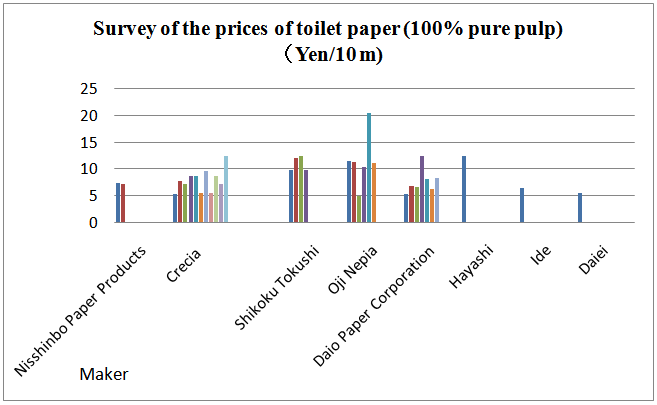 | Figure 3. Prices of toilet paper/10 m made of virgin pulp produced by different manufacturers (including value-added products) |
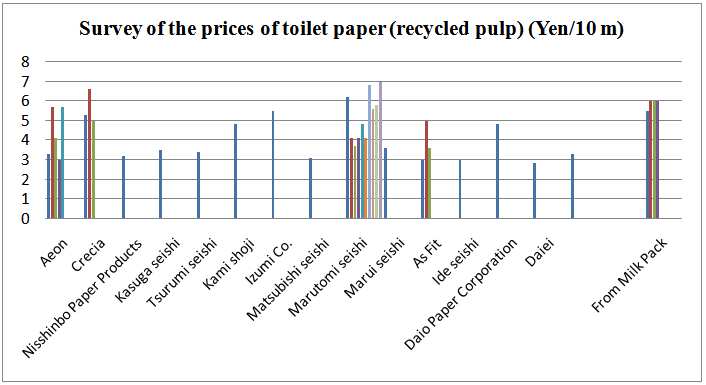 | Figure 4. Prices of toilet paper/10 m made of recycled pulp (including milk cartons) produced by different manufacturers |
3.3. Current Status of Recycled Paper Products
- When viewed from the standpoint of the “correlation between prices and the environmental burden”, it was suggested that the recycling of waste paper, excluding milk cartons and other specially processed waste paper, into toilet paper and other products was a very effective environmental activity in terms of economy or prices.When producing recycled paper, two characteristics of paper, “strength” and “whiteness”, should be taken into consideration. The prices of copy paper made of virgin and recycled pulp were compared (Figure 5).
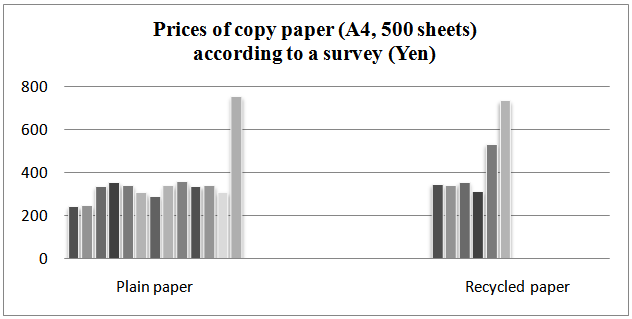 | Figure 5. A comparison of the prices of copy paper made of virgin and recycled pulp |
|
4. An Examination of the Relationship between Paper Recycling and the Environmental Burden
- The following is an examination of paper recycling as an eco-activity and its effect of reducing the environmental burden: As explained in Chapter 3, paper can be recycled, and effective methods have already been developed. Therefore, paper recycling actually reduces the use of new paper. However, various forms of burden are placed on the environment in the process of paper manufacturing, and few studies have been conducted to examine the methods for reducing them. In the following paragraph, approaches adopted by Japanese paper manufacturing companies are discussed:
4.1. Approaches by the Paper Manufacturing Industry
- In prominent Japanese paper manufacturing companies, there is a dispute over “recycled paper” [16-18]. It was triggered in April 2007, when Nippon Paper Industries Co., Ltd., which has the second largest market share in Japan, published a comment: “Production of paper using 100% recycled pulp increases CO2 emissions”. The background is explained in the following paragraph:Prior to the announcement by Nippon Paper Industries in 2007, the paper manufacturing industry was involved in the development of paper products including a large percentage of recycled pulp. It had been believed that recycled paper made of 100% pulp was environmentally friendly and would help paper manufacturing companies create a positive image. In fact, Daio Paper Corporation, which has the third largest market share in Japan, attracted public attention around 2000, when they succeeded in producing newspaper made of 100% recycled pulp [19]. The government also recommended the use of paper including a large percentage of recycled pulp, which had a significant influence on the industry’s approach to paper recycling. However, some paper manufacturing companies have questioned the validity of paper made of 100% recycled pulp, suggesting that these products may not be environmentally friendly. One of them is Oji Paper Co., Ltd., which has the largest market share in Japan. In response to this, Nippon Paper Industries with the second largest market share discontinued the distribution of paper products made of 100% recycled pulp. To make things worse, a case of fraud regarding the ratio between recycled and virgin pulp was brought to light in January 2008, and so the public image of the environmental activities of the industry became even worse [20].
4.2. Discussion on Paper Recycling and the Environmental Burden
- However, they only suggest that paper products made of 100% recycled pulp are environmentally unfriendly, and not paper recycling. Both Oji Paper and Nippon Paper Industries agree on the “best ratio of recycled to virgin pulp of 60 to 70%”. Their suggestions are based on the concept of “carbon-neutral”. Figure 6 shows the grounds for the discontinuation of the above-mentioned recycled paper products by Nippon Paper Industries [21]. As the figure shows, the ratio of CO2 emissions from the production of products made of 100% virgin to recycled pulp is 100:86. However, according to the concept of carbon-neutral, CO2 emissions from non-fossil fuel are not counted. Therefore, it is believed that the production of paper made of 100% recycled pulp generates smaller amounts of CO2 emissions. Since non-fossil fuel is black liquor produced in the process of pulping trees and plants, CO2 emissions generated by burning this liquor derived from plants are not taken into account based on the concept of carbon-neutral. But, this is correct only in theory, and the actual amount of CO2 emissions from 100% recycled pulp is smaller. The figure also shows that significantly larger amounts of CO2 emissions are generated in the process of paper manufacturing than in the stage of the procurement of materials.
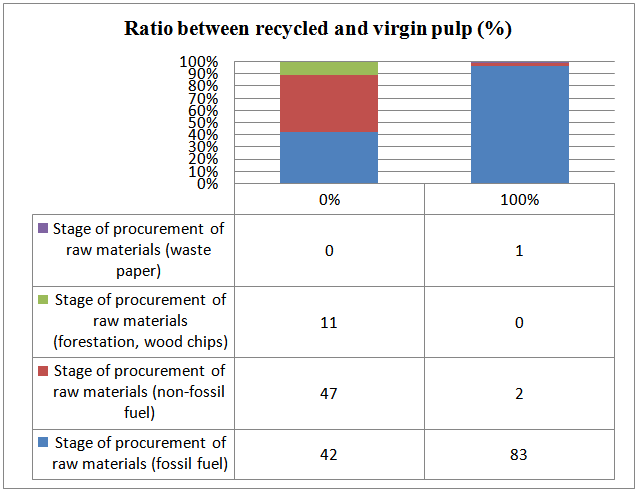 | Figure 6. CO2 emissions generated by producing paper made of 100% recycled and virgin pulp |
5. Conclusions
- As discussed in the preceding paragraphs, paper recycling is partially effective. This is reflected in the current situation in which low-quality recycled paper is required and materials that can easily be recycled, including “damaged paper”, are useful resources. Whereas virgin pulp is suited to the production of high-quality paper products, such as New Year’s postcards, recycled paper can be used as a valuable resource to produce cardboard, magazines, and other low-quality recycled paper products.However, paper recycling does not directly reduce the environmental burden even if it is feasible. The results suggested that the environmental burden was not reduced as expected, since there were significant differences in the processes of producing paper using recycled and virgin pulp. “The production of paper including a large percentage of recycled pulp requires a large amount of fossil fuel”, and “larger amounts of CO2 are emitted by producing paper made of a small percentage of recycled pulp because larger areas are deforested”. In the current situation, people are required to make a decision on measures for reducing the environmental burden. The government officials and researchers involved in environmental issues should clearly suggest environmental measures to be selected by consumers and companies. They should also recommend that waste and damaged paper be utilized appropriately, which will allow paper manufacturing companies to omit bleaching procedures and reduce the environmental burden.However, even the main premise of paper recycling has been questioned in recent years. There has been an increase in the use of virgin pulp to produce toilet paper, which is a low-quality recycled paper product, and an unacceptable lie was uncovered in January 2008, involving fabricating the ratio between recycled and virgin pulp. Why did that paper manufacturing company, which produces toilet paper made of virgin pulp and stresses this point, have to conceal their use of virgin pulp for New Year’s postcards? The government and the attitudes of consumers are also responsible for this. An increasing number of consumers have become interested in purchasing quality toilet paper and other paper products that are not necessarily required to be of high quality, and prefer recycled paper products that should actually not include recycled pulp. The government has failed to understand the essence of recycling technologies: the Act on Promoting Green Purchasing has restricted the activities of paper manufacturing companies and, according to the definition of waste paper established by the government, damaged paper is included.Recycling is not an all-round environmental measure, but encompasses technologies that enable the reuse of resources. Therefore, recycling has technical limitations, and when recycling activities are performed, an environmental burden is unavoidable. Paper manufacturing companies, the government, and consumers should discuss what recycling activities are effective, including their methods, and implement them in collaboration with each other.
 Abstract
Abstract Reference
Reference Full-Text PDF
Full-Text PDF Full-text HTML
Full-text HTML